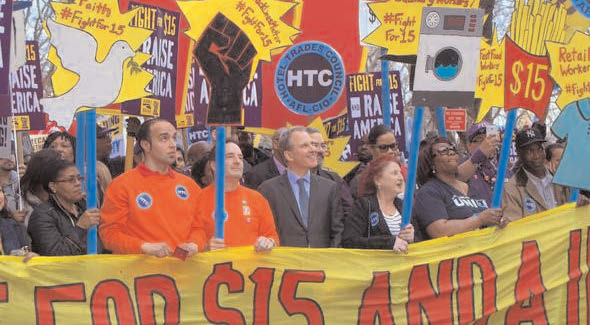
The benefits of a hike would go beyond those who receive it. For each dollar the minimum wage is increased, economists estimate it boosts consumer spending by $2,800 per affected household. A minimum wage hike can stimulate the economy”, says the author.
Support is growing across New York State for increasing the minimum wage to $15 an hour. More than two-thirds of New Yorkers agree that working men and women need a raise. The Legislature should give them one, or Gov. Cuomo should take action.
The reasons to increase the minimum wage are as clear as they are compelling. Paying a fair wage is a statement of our basic values. When we allow our fellow New Yorkers to work full-time and live in poverty, we are sending a message that we do not value them.
And when we permit large employers to force taxpayers to foot the bill for major costs of doing business – by offering food stamps and other state benefit programs so workers can provide for their families – we send a message that New York is willing to subsidize companies that pay poverty wages. As one study revealed, more than 50% of low-wage workers are on public assistance, costing state and local taxpayers approximately $9 billion over the past two years.
Let’s be clear: The minimum wage affects more than just high-school kids looking to make a few extra dollars. According to official state Department of Labor statistics from February, half of all workers earning less than $15 per hour are 35 or older. In New York City, 80% of minimum-wage workers are over age 25.
According to the Economic Policy Institute, statewide, 53% of minimum wage workers are women and 50% are people of color.
The benefits of a hike would go beyond those who receive it. For each dollar the minimum wage is increased, economists estimate it boosts consumer spending by $2,800 per affected household. A minimum wage hike can stimulate the economy.
And recent history shows that a minimum wage hike is not a “job-killing tax.” Quite the opposite. In 2014, more than a dozen states – including New York – increased their state minimum wage. In the months that followed, these states experienced higher rates of employment growth than the national average, according to analyses by economists at Goldman Sachs and the Center for Economic and Policy Research.
Nor is $15 an arbitrary number, as some suggest. As one analysis showed, if the minimum wage had just kept up with inflation since 1970, it would nearly match the governor’s five-year phase-in plan, which would raise the pay floor to that level in New York City by 2018 and in other parts of the state by 2021.
We can address this problem in one of two ways. The Legislature can enact an across-the-board increase. Or, under state law, the commissioner of the Department of Labor can convene a wage board to examine conditions in a specific occupations and determine whether an increase in wages is necessary because current wages are inadequate to provide for workers and their families.
Last year, New York convened a wage board to address the woefully low wages for fast-food workers. Over two months, the board heard testimony from employees, employers and industry experts, and reviewed statistics and studies describing the conditions in the industry.
When confronted with the harsh reality of what it is like to live on poverty wages and work in the fast-food industry, the wage board voted to raise the minimum wage for fast-food workers at large chains to $15 per hour. As a result, as many as 200,000 fast food workers will earn a true living wage by 2021.
There are many other industries – from home-care to retail -where the current minimum wage is inadequate. It is time to send the simple message that all New Yorkers deserve a fair day’s pay for a fair day’s work.
Gov. Cuomo can use his power to create more wage boards to critically examine whether workers in other occupations face similar conditions and therefore deserve a similar raise. But the best solution is for the legislature to pass a law this session raising the state’s minimum wage to $15 per hour for all workers.





Be the first to comment